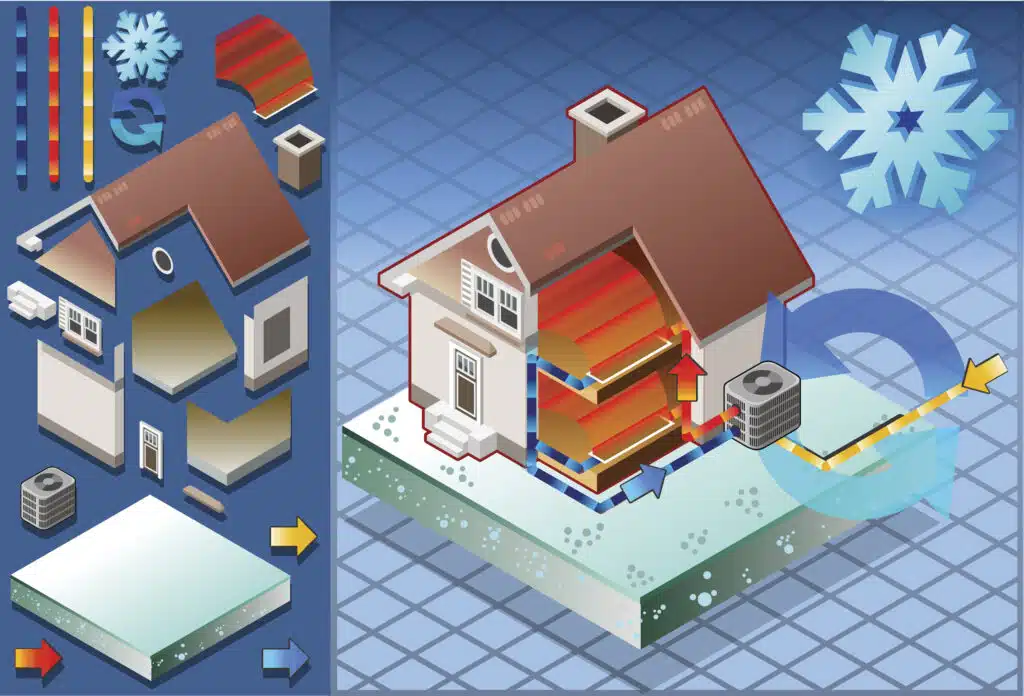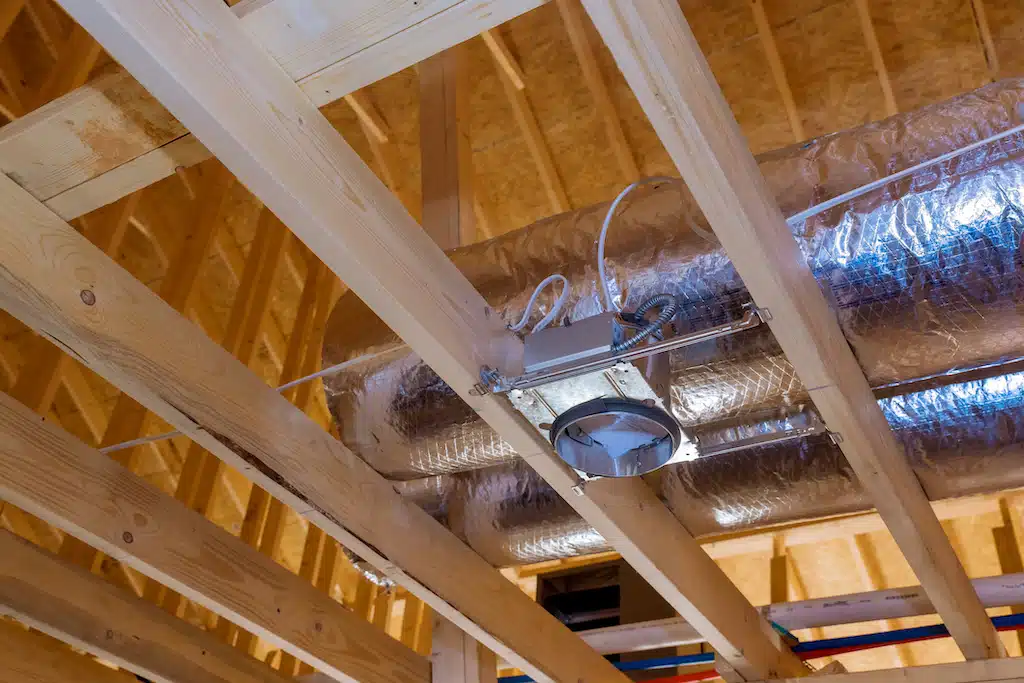
Best Practices for HVAC Zoning Systems
HVAC zoning systems enhance home comfort and energy efficiency by allowing individual temperature control in different areas or “zones.” Here’s how they benefit homeowners:
- Customized Comfort: Set specific temperatures for each zone—cool the living room while keeping the bedroom warmer.
- Energy Savings: Heat or cool only the zones in use, significantly reducing energy consumption and lowering utility bills.
- Increased Efficiency: Reduce wear and tear on your HVAC system, extending its lifespan and decreasing the frequency of repairs.
- Environmentally Friendly: Lower energy usage results in a reduced carbon footprint, promoting a greener lifestyle.
Understanding and installing the right zoning system can optimize home heating and cooling, aligning comfort with cost-effectiveness and environmental responsibility.
Have you ever wondered how to make your home’s heating and cooling more efficient?
HVAC zoning systems might be the solution you need. These systems allow for customized temperature control in different areas of your home, enhancing comfort and reducing energy costs.
HVAC zoning systems divide your home into sections, or zones, each with its own thermostat. This setup lets you heat or cool only the areas you need, when you need them. Imagine not having to waste energy on an empty guest room or an unoccupied basement. With HVAC zoning, this becomes a reality.
HVAC zoning systems are a smart investment for any homeowner looking to improve comfort, save energy, and reduce their environmental impact. In the following sections, we will delve deeper into how these systems work, their types, benefits, and more.
How HVAC Zoning Systems Work
Understanding how HVAC zoning systems work can help you appreciate their benefits even more. These systems rely on a few key components that work together to control the temperature in different areas of your home.
The main components of an HVAC zoning system include thermostats, dampers, and control panels. Each zone in your home has its own thermostat, which allows you to set the desired temperature for that area. These thermostats communicate with a central control panel, which manages the operation of the dampers.
Dampers are valves or plates that regulate air flow within your ductwork. They are usually installed near the main trunk line and can open or close to direct air to specific zones. When a thermostat in a particular zone calls for heating or cooling, the control panel signals the corresponding damper to open, allowing conditioned air to flow into that zone. Meanwhile, dampers in zones that don’t require conditioning will remain closed, preventing air from being wasted in those areas.
The basic operation mechanism of HVAC zoning systems is straightforward. When you adjust a thermostat, it sends a signal to the control panel. The control panel then activates the appropriate dampers and adjusts the HVAC system’s output to meet the demand. This ensures that only the zones that need heating or cooling receive it, improving overall efficiency and comfort.
There are different types of HVAC zoning systems to consider.
- Single-zone systems: These are ideal for smaller homes or single-story residences where precise control over different areas is less critical.
- Multi-zone systems: Perfect for larger homes with multiple stories or distinct living areas. These systems offer more flexibility and control, allowing you to maintain different temperatures in various zones.
Dampers can also be manual or automatic. Manual dampers require you to adjust them by hand, while automatic dampers are controlled electronically by the system’s control panel. Automatic dampers are more convenient and efficient, as they adjust in real-time based on the thermostat settings.
Another option is ductless mini-splits. These systems don’t use ductwork and are ideal for homes without existing duct systems or for adding zones to specific areas. They consist of an outdoor unit connected to one or more indoor units, each capable of controlling the temperature in a separate zone.
HVAC zoning systems work by using thermostats, dampers, and control panels to direct air flow precisely where it’s needed. By understanding these components and how they interact, you can make informed decisions about which type of system is best for your home.
Types of HVAC Zoning Systems
When choosing an HVAC zoning system, understanding the different types available can help you make the best decision for your home. Each type of system has unique features and benefits, catering to various needs and preferences.
Single-Zone vs. Multi-Zone Systems
Single-zone systems are designed to control the temperature of one area or zone. They are often used in smaller homes or individual rooms where precise control over multiple areas is unnecessary. These systems are simpler and less expensive but offer limited flexibility compared to multi-zone systems.
Multi-zone systems, on the other hand, can manage the climate in multiple zones within your home. This is ideal for larger homes or properties with distinct living areas. For example, you can keep the living room comfortable during the day while maintaining a different temperature in the bedrooms. Multi-zone systems provide greater flexibility and control, ensuring each area of your home is at the perfect temperature.
Manual Dampers vs. Automatic Dampers
The dampers in an HVAC zoning system control the airflow to different zones. Manual dampers require you to adjust them by hand. They are less expensive but less convenient, as you need to manually change the settings whenever you want to adjust the airflow.
Automatic dampers are controlled electronically and adjust in real-time based on thermostat settings. These dampers offer more convenience and efficiency, as they respond automatically to changes in your home’s heating or cooling needs. This type of damper is ideal for homeowners who want a hassle-free system that adjusts itself as needed.
Ductless Mini-Splits
Ductless mini-splits are another type of HVAC zoning system that doesn’t rely on traditional ductwork. These systems are perfect for homes without existing ducts or for adding zones to specific areas, such as home additions or converted garages. A ductless mini-split system consists of an outdoor unit connected to one or more indoor units, each capable of controlling the temperature in a separate zone.
Ductless mini-splits offer several advantages, including easy installation and high energy efficiency. They are also very flexible, allowing you to control the temperature in each zone independently. This makes them an excellent choice for homes with unique heating and cooling needs.
Comparing Different Systems
When comparing different HVAC zoning systems, consider factors such as the size of your home, your comfort preferences, and your budget. Single-zone systems are more affordable and simpler but offer less control over different areas. Multi-zone systems provide greater flexibility and comfort but come at a higher cost.
Manual dampers are cheaper but require more effort to adjust, while automatic dampers offer convenience and better efficiency. Ductless mini-splits are versatile and efficient, making them suitable for homes without existing ductwork or for creating additional zones.
By understanding the types of HVAC zoning systems available, you can choose the best option for your home, ensuring maximum comfort and efficiency.
Benefits of HVAC Zoning Systems
Investing in an HVAC zoning system can provide a myriad of benefits, making it a wise choice for many homeowners. These systems are designed to optimize comfort, enhance energy efficiency, and extend the lifespan of your HVAC equipment.
Enhanced Comfort
One of the most significant benefits of HVAC zoning systems is the enhanced comfort they offer. Traditional HVAC systems force you to maintain a uniform temperature throughout your home. This often leads to discomfort, as different areas may have varying temperature needs.
With zoning, you can set different temperatures for each zone, ensuring that every room is comfortable for its occupants. For instance, you can keep bedrooms cooler at night while maintaining a warmer living room during the day.
Energy Efficiency
Energy efficiency is another crucial advantage. By only heating or cooling the zones that are in use, you can significantly reduce energy consumption. Traditional systems often waste energy by conditioning unoccupied rooms, but zoning systems eliminate this inefficiency. This targeted approach to heating and cooling can lead to noticeable reductions in your energy bills.
Cost Savings
The cost savings from improved energy efficiency can be substantial over time. Although the initial investment in an HVAC zoning system may be higher than a traditional system, the long-term savings on energy bills can offset this cost. Additionally, zoning systems reduce the strain on your HVAC equipment, potentially lowering maintenance and repair costs.
Extended Equipment Lifespan
Extended equipment lifespan is another benefit of HVAC zoning systems. By reducing the workload on your HVAC system, zoning helps prevent excessive wear and tear. Your equipment doesn’t have to work as hard to maintain a comfortable temperature throughout your home, which can lead to fewer breakdowns and a longer lifespan for your system.
Environmental Benefits
Reducing energy consumption also has significant environmental benefits. Using less energy means a lower carbon footprint, contributing to a more sustainable and eco-friendly home. For homeowners concerned about their environmental impact, HVAC zoning systems offer a practical way to make a positive difference.
HVAC zoning systems provide enhanced comfort, energy efficiency, cost savings, extended equipment lifespan, and environmental benefits. These advantages make zoning systems a smart investment for any homeowner looking to improve their home’s heating and cooling efficiency.
Designing an HVAC Zoning System
Designing an effective HVAC zoning system requires careful planning and consideration of various factors. To ensure optimal performance and comfort, it’s important to tailor the system to your home’s unique needs.
Building Layout and Architecture Considerations
The first step in designing an HVAC zoning system is to assess the building layout and architecture. Consider the size and shape of your home, the number of floors, and the arrangement of rooms.
Homes with open floor plans, multiple stories, or large areas may benefit from multiple zones to maintain consistent comfort. Identify areas with distinct heating and cooling needs, such as bedrooms, living rooms, and basements, and plan to create separate zones for these spaces.
Occupant Preferences and Comfort Levels
Understanding the preferences and comfort levels of the occupants is crucial. Different family members may have varying temperature preferences. For instance, some may prefer cooler bedrooms for better sleep, while others may want a warmer home office during work hours.
By creating zones based on these preferences, you can ensure that everyone in your home stays comfortable. Consider the daily routines and habits of the occupants to determine the most effective zoning strategy.
Energy Efficiency and Cost Considerations
Energy efficiency is a key factor when designing an HVAC zoning system. An efficient system not only reduces energy consumption but also lowers utility bills. To maximize efficiency, consider the insulation and sealing of your home.
Well-insulated homes retain conditioned air better, reducing the workload on your HVAC system. Also, think about the cost considerations. While zoning systems can be more expensive upfront, the long-term savings on energy bills and reduced wear and tear on your HVAC equipment can make them a cost-effective choice.
To achieve the best balance between comfort and efficiency, you might need to invest in energy-efficient components such as programmable thermostats and automatic dampers. These devices can optimize the performance of your HVAC zoning system by allowing precise control over each zone.
Designing an HVAC zoning system involves careful consideration of your home’s layout, occupant preferences, and energy efficiency goals. Whether installing a new system or retrofitting an existing one, proper planning and professional guidance are key to creating an effective and efficient zoning system.
Installation of HVAC Zoning Systems
Installing an HVAC zoning system involves several important steps and considerations, whether you are integrating a new system or retrofitting an existing one. Proper installation ensures that your system operates efficiently and provides maximum comfort.
New Installations vs. Retrofitting Existing Systems
New installations offer the advantage of designing the zoning system from the ground up. When building a new home or during a major HVAC system replacement, you can plan the ductwork, dampers, and thermostats to work seamlessly together. This approach allows for optimal placement and integration of all components, ensuring that each zone is effectively managed.
Retrofitting existing systems involves modifying your current HVAC setup to include zoning capabilities. While this can be more complex, it is often a viable option for homeowners who want to improve comfort and efficiency without replacing their entire system. Retrofitting typically involves adding dampers, additional thermostats, and a control panel to your existing ductwork.
Steps and Considerations for Installation
Assessment and Planning
The first step in installing an HVAC zoning system is a thorough assessment of your home’s layout and HVAC requirements. An HVAC professional will evaluate your current system, ductwork, and the specific needs of each zone. This assessment helps in planning the placement of dampers, thermostats, and control panels.
Ductwork Modification
For both new installations and retrofits, modifying the ductwork is a crucial step. This involves installing dampers in the main duct lines that supply air to different zones. These dampers can be either manual or automatic, with automatic dampers providing greater convenience and efficiency.
Thermostat Installation
Each zone in your home will require its own thermostat. These thermostats should be strategically placed to accurately measure and control the temperature in their respective zones. In multi-story homes, it’s important to consider the natural variations in temperature between levels and place thermostats accordingly.
Control Panel Setup
The control panel is the brain of your HVAC zoning system. It receives signals from the thermostats and adjusts the dampers and HVAC system operation accordingly. Proper setup and programming of the control panel are essential for the system to function correctly. An HVAC professional will ensure that the control panel is configured to manage the zones efficiently.
Testing and Calibration
Once the system is installed, thorough testing and calibration are necessary. This process involves checking that all components are working correctly, the dampers are opening and closing as needed, and the thermostats are accurately reading and controlling the temperatures. Any adjustments needed for optimal performance will be made during this phase.
Cost Considerations
When considering the cost of installing an HVAC zoning system, several factors come into play:
- Number of Zones: More zones require additional thermostats, dampers, and more complex control systems, increasing the cost.
- Type of Dampers: Automatic dampers are more expensive than manual ones, but they offer greater convenience and efficiency.
- Retrofitting vs. New Installation: Retrofitting can be more labor-intensive and costly compared to new installations, which can be planned and executed more efficiently from the start.
However, it’s important to weigh these costs against the long-term savings. Zoning systems can significantly reduce energy bills by only heating or cooling the areas in use, leading to substantial savings over time.
Additionally, the increased comfort and extended lifespan of your HVAC equipment add value to the investment.
installing an HVAC zoning system, whether new or retrofitted, involves careful planning, professional assessment, and precise execution. While the initial costs may vary, the long-term benefits of enhanced comfort, energy efficiency, and potential savings make it a worthwhile investment.
Common Issues and Solutions
Even the best HVAC zoning systems can encounter issues. Knowing what problems to expect and how to address them can help maintain your system’s efficiency and comfort.
Hot and Cold Spots
Hot and cold spots are one of the most common issues in HVAC zoning systems. These occur when certain zones are not receiving adequate airflow, resulting in uneven temperatures throughout your home.
Solutions:
- Check Dampers and Vents: Ensure that all dampers and vents are open and unobstructed. Sometimes, closed or blocked vents can restrict airflow to certain areas.
- Balance the System: Adjust the dampers to direct more airflow to the problematic zones. This might require professional help to ensure optimal balance.
- Insulation: Improve insulation in areas experiencing temperature extremes. Poor insulation can lead to heat loss or gain, affecting the efficiency of your HVAC system.
System Imbalances
System imbalances occur when one zone consistently requires more heating or cooling than others, leading to uneven wear on the HVAC system. This can cause inefficiencies and increase energy costs.
Solutions:
- Reevaluate Zone Design: Ensure that the zones are designed logically, grouping areas with similar heating and cooling needs.
- Adjust Thermostat Settings: Sometimes, simply adjusting the thermostat settings can help balance the demand across different zones.
- Professional Assessment: A professional can evaluate your system and suggest modifications to improve balance and efficiency.

Maintenance Tips
Regular maintenance is crucial to keep your HVAC zoning system running smoothly. Here are some essential maintenance tips:
Air Filters
Air filters should be checked and replaced regularly. Dirty filters can restrict airflow, causing the system to work harder and reducing efficiency.
Thermostat Calibration
Ensure that your thermostats are correctly calibrated. Incorrect readings can lead to inefficient heating or cooling. Professional calibration may be necessary to ensure accurate temperature control.
Ductwork Inspection
Inspect the ductwork periodically for leaks or damage. Leaky ducts can lead to air loss and decreased system efficiency. Sealing any leaks can improve performance and reduce energy costs.
Seasonal Checks
Perform seasonal checks before the start of the heating and cooling seasons. Ensure that the system components, such as dampers and control panels, are functioning correctly. This proactive approach can prevent issues during peak usage times.
While HVAC zoning systems can face issues like hot and cold spots or system imbalances, these problems are often manageable with proper maintenance and professional assistance. Regularly checking and maintaining your system can ensure it operates efficiently, providing consistent comfort throughout your home.
FAQs about HVAC Zoning Systems
- What is an HVAC zoning system, and how does it work?
An HVAC zoning system divides your home into different zones, each with its own thermostat. This setup allows you to control the temperature in each zone independently. The system uses dampers in the ductwork to direct air to specific areas based on the thermostat settings, ensuring each zone is comfortable without wasting energy on unused spaces.
- How can HVAC zoning systems save energy and reduce costs?
HVAC zoning systems save energy by only heating or cooling the areas in use, rather than conditioning the entire house. This targeted approach reduces energy consumption, leading to lower utility bills. Over time, the savings on energy costs can offset the initial investment in the zoning system.
- Can I retrofit my existing HVAC system with zoning?
Yes, you can retrofit your existing HVAC system with zoning. This process involves adding dampers, additional thermostats, and a control panel to your current setup. While retrofitting can be more complex and costly than installing a new system, it can significantly improve comfort and efficiency without requiring a complete system replacement.
- What are the common problems with HVAC zoning systems, and how can I fix them?
Common problems with HVAC zoning systems include hot and cold spots, system imbalances, and airflow issues. To fix these:
- Hot and Cold Spots: Ensure dampers and vents are open and unobstructed, balance the system, and improve insulation.
- System Imbalances: Reevaluate zone design, adjust thermostat settings, and consult with a professional.
- Airflow Issues: Check for leaky or blocked ducts and replace dirty air filters.
- How often should I maintain my HVAC zoning system?
Regular maintenance is crucial for optimal performance. Here are some maintenance tips:
- Air Filters: Check and replace air filters every 1-3 months.
- Thermostats: Ensure thermostats are calibrated correctly.
- Ductwork: Inspect ducts periodically for leaks and damage.
- Seasonal Checks: Perform seasonal checks before the heating and cooling seasons to ensure all components are functioning correctly.



